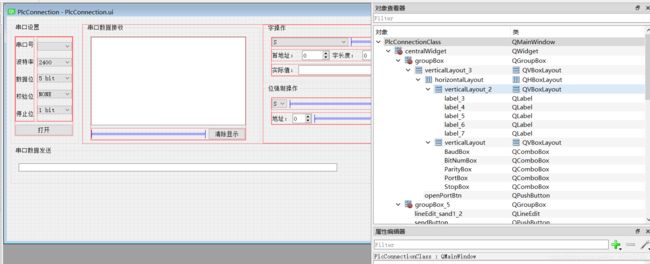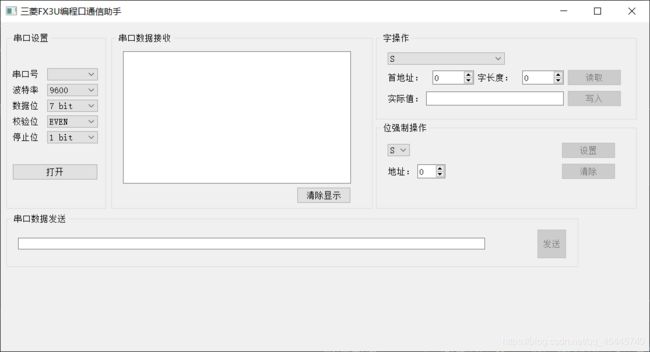三菱PLC与上位机进行通讯
三菱PLC与上位机串口通信
- 一.三菱Fx系列PLC编程口通讯协议地址算法
-
- 1.DEVICE READ(读出软设备状态值)
- 2.DEVICE WRITE(向PLC 软设备写入值)
- 3.位设备强制置位/复位
- 4.三菱Fx系列PLC地址对应表
- 二.源代码
-
- 1.ui文件
- 2.PlcConnection.h
- 3.PlcConnection.cpp
- 4.main.cpp
- 参考资料:
一.三菱Fx系列PLC编程口通讯协议地址算法
三菱PLC编程口通讯协议三菱PLC编程口的通讯协议只有四个命令:
| 命令 | 命令码 | 目标设备 |
|---|---|---|
| DEVICE READ CMD | “0” | X,Y,M,S,T,C,D |
| DEVICE WRITE CMD | “1” | X,Y,M,S,T,C,D |
| FORCE ON CMD | “7” | X,Y,M,S,T,C |
| FORCE OFF CMD | “8” | X,Y,M,S,T,C |
五个标示:
| ENQ | 05H | 请求 |
|---|---|---|
| ACK | 06H | PLC正确响应 |
| NAK | 15H | PLC错误响应 |
| STX | 02H | 报文开始 |
| ETX | 03H | 报文结束 |
使用累加方式的和校验,帧格式如下:
STX CMD DATA … DATA ETX SUM(upper) SUM(lower)
和校验:
SUM= CMD+……+ETX。 如SUM=73H,SUM=“73”。
1.DEVICE READ(读出软设备状态值)
计算机向PLC发送:
始命令 首地址 位数 终和校验
STX CMD GROUP ADDRESS BYTES ETX SUM
PLC 返回
STX 1ST DATA 2ND DATA … LAST DATA ETX SUM
2.DEVICE WRITE(向PLC 软设备写入值)
计算机向PLC发送:
始命令 首地址 位数 数据 终和校验
PLC 返回
ACK (06H) 接受正确
NAK (15H) 接受错误
3.位设备强制置位/复位
FORCE ON 置位
始命令 地址 终和校验
STX CMD ADDRESS ETX SUM
02H 37H ADDRESS 03H SUM
FORCE OFF 复位
始 命令 地址 终 和校验
STX CMD ADDRESS ETX SUM
02H 38H ADDRESS 03H SUM
PLC 返回
ACK(06H) 接受正确
NAK(15H) 接受错误
4.三菱Fx系列PLC地址对应表
以上就是这些协议,但是由于没有寄存器类型信息,所以地址的计算十分关键,如D100和M100分别对应哪个地址呢?下面就是三菱Fx系列PLC地址对应表。
Public Const PLC_D_Base_AddRess = 4096
Public Const PLC_D_Special_Base_AddRess = 3584
Public Const PLC_Y_Group_Base_AddRess = 160
Public Const PLC_PY_Group_Base_AddRess = 672
Public Const PLC_T_Group_Base_AddRess = 192
Public Const PLC_OT_Group_Base_AddRess = 704
Public Const PLC_RT_Group_Base_AddRess = 1216
Public Const PLC_M_SINGLE_Base_AddRess = 2048(命令为7或8时)
Public Const PLC_M_Group_Base_AddRess = 256
Public Const PLC_PM_Group_Base_AddRess = 768
Public Const PLC_S_Group_Base_AddRess = 0
Public Const PLC_X_Group_Base_AddRess = 128
Public Const PLC_C_Group_Base_AddRess = 448
Public Const PLC_OC_Group_Base_AddRess = 960
Public Const PLC_RC_Group_Base_AddRess = 1472
Public Const PLC_TV_Group_Base_AddRess = 2048
Public Const PLC_CV16_Group_Base_AddRess = 2560
Public Const PLC_CV32_Group_Base_AddRess = 3072
当我们用DEVICE READ命令时,D100地址=100*2+4096;M100地址=100+256;不同的是D类型寄存器存放的是字,M寄存器存放的是位,同样是读两个字节,D100返回的就是PLC中D100地址的值,M类型寄存器返回的是M100到M116的值。所以当我们用FORCE ON 命令时,M100寄存器地址=100+2048;
但三菱公司好像不甘于如此,FORCE ON/Off命令中地址排列与DEVICE READ/WRITE不同,是低位在前高位在后。如Y20,地址是0510H,代码中4个字节地址表示为:1005。(注意:Y寄存器为八进制,如Y20地址=16+1280=0510H)
二.源代码
1.ui文件
2.PlcConnection.h
#ifndef MAINWINDOW_H
#define MAINWINDOW_H
#include "ui_PlcConnection.h"
#include 3.PlcConnection.cpp
#include "PlcConnection.h"
#include 4.main.cpp
#pragma execution_character_set("utf-8")
#include "PlcConnection.h"
#include 


